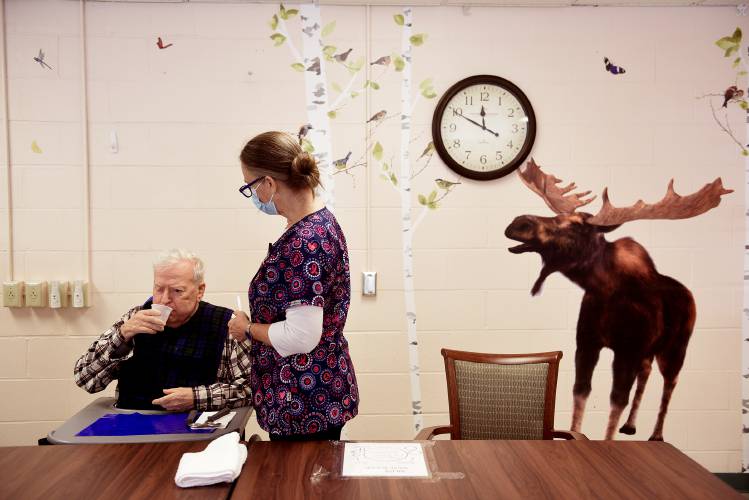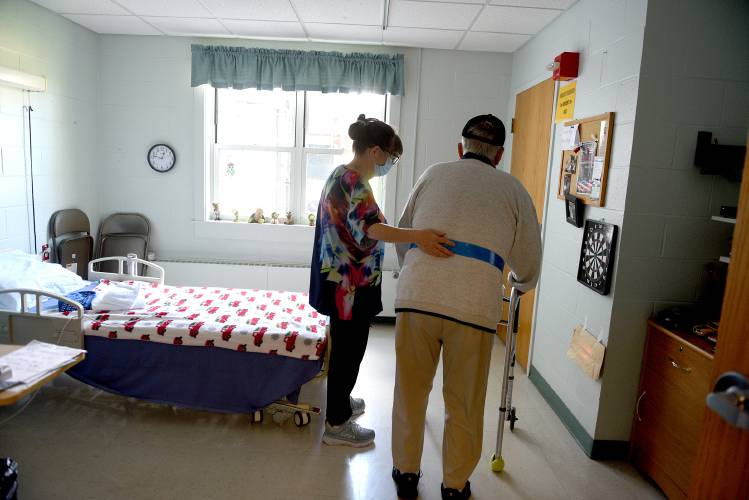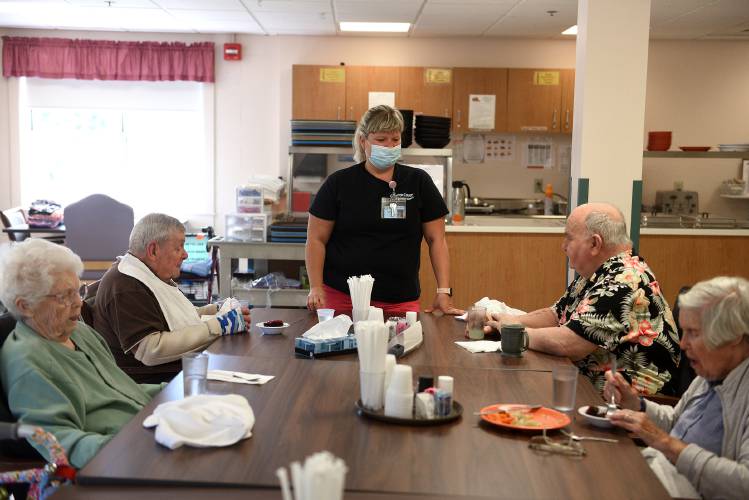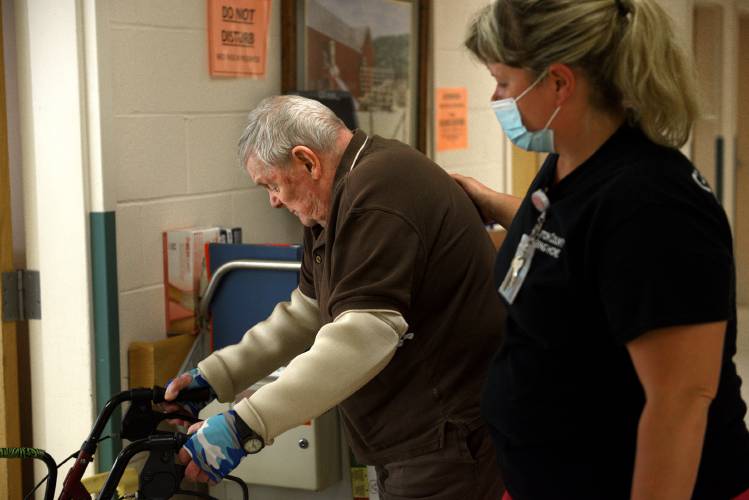 Registered nurse Melody Gibson gives Grafton County Nursing Home resident Bill Signs, 75, his medication just before lunch on Thursday, Sept. 14, 2023, in North Haverhill, NH. Proposed federal staffing rules include requiring a registered nurse be on site 24 hours a day. (Valley News - Jennifer Hauck) Copyright Valley News. May not be reprinted or used online without permission. Send requests to permission@vnews.com. Valley News photographs — Jennifer Hauck
Registered nurse Melody Gibson gives Grafton County Nursing Home resident Bill Signs, 75, his medication just before lunch on Thursday, Sept. 14, 2023, in North Haverhill, NH. Proposed federal staffing rules include requiring a registered nurse be on site 24 hours a day. (Valley News - Jennifer Hauck) Copyright Valley News. May not be reprinted or used online without permission. Send requests to permission@vnews.com. Valley News photographs — Jennifer Hauck
NORTH HAVERHILL — Administrators of Upper Valley nursing homes are balking at proposed changes to federal staffing requirements, which they say would be difficult for them to meet and could put beds offline, reducing the availability of long-term care in the region.
But nursing organizations say it’s not a question of whether to bolster staffing in nursing homes, but how.
The Biden administration has proposed new rules for long-term care facilities that accept payments from the government insurance programs Medicare and Medicaid as a way of improving safety. Outbreaks of COVID-19 during the public health emergency, which ended in May, led to illness and deaths of residents and workers.
But the proposed new rules come as nursing homes are already struggling to meet current staffing requirements.
Issued Sept. 1, the rules are informed by a 2022 nursing home staffing study commissioned by the Centers for Medicare and Medicaid Services (CMS). They include a requirement that facilities have a registered nurse on site 24 hours a day, seven days a week. That would be an increase from eight hours a day under the current regulations, which allow licensed practical nurses to provide care in nursing homes during the other 16 hours a day.
The rules include other new requirements establishing minimum nurse staffing standards of 2.45 hours per resident per day for nurse aides and 0.55 hours per resident day for RNs, as well as additional reporting requirements. But ensuring round-the-clock RN availability was most concerning to Upper Valley nursing home administrators.
“We have five (full-time equivalents) open at the moment for registered nurses,” Craig Labore, administrator for Grafton County Nursing Home in North Haverhill, said. “We don’t have the coverage now.”
 Licensed nursing assistant Rhonda Benjamin helps resident Fred Page, 86, back to his room after lunch at the Grafton County Nursing Home in North Haverhill, N.H. on Thursday, Sept. 14, 2023. (Valley News - Jennifer Hauck) Copyright Valley News. May not be reprinted or used online without permission. Send requests to permission@vnews.com. Jennifer Hauck
Licensed nursing assistant Rhonda Benjamin helps resident Fred Page, 86, back to his room after lunch at the Grafton County Nursing Home in North Haverhill, N.H. on Thursday, Sept. 14, 2023. (Valley News - Jennifer Hauck) Copyright Valley News. May not be reprinted or used online without permission. Send requests to permission@vnews.com. Jennifer Hauck
Grafton County Nursing Home has 135 beds but only has sufficient staff to operate at about 72% occupancy, as it has been for the past couple of years, Labore said.
“We were just never able to really recover,” he said of the loss of workers during the COVID-19 pandemic.
Nationally, 100,000 registered nurses left their jobs during the pandemic, according to a study released in April by the National Council of State Boards of Nursing. In addition, nearly 900,000, or one-fifth of the country’s RNs, reported an “intent to leave” by 2027 due to stress, burnout and retirement, according to the national council’s report.
“There’s just not enough registered nurses in the workforce right now to be in compliance with the regulation,” Labore said of the proposed changes issued by CMS. There is a 60-day comment period on the proposed changes. Comments can be submitted by Nov. 6 online at federalregister.gov/public-inspection/current.
The staffing picture in nursing homes is grim and goes beyond the number of nurses who have left their jobs. Nursing homes alone lost 210,000 workers from February 2020 to December 2022, according to a January report from the American Health Care Association and National Center for Assisted Living. These job losses come amid a very tight labor market; in the Twin States, the unemployment rate sits below 2%, which makes it difficult to find new workers to fill vacancies.
Nationally, ramping up staffing as required by the new rule is expected to cost $40.6 billion over 10 years.
 Residents Bea Wendell, 90, left, Paul Pinkham, 86, Dean Hurlbert, 80, and Betty Kane, 96, finish up their lunch at the Grafton County Nursing Home with licensed nursing assistant Raylynn Taylor checking in on them on Thursday, Sept. 14, 2023, in North Haverhill, N.H. (Valley News - Jennifer Hauck) Copyright Valley News. May not be reprinted or used online without permission. Send requests to permission@vnews.com. Valley News — Jennifer Hauck
Residents Bea Wendell, 90, left, Paul Pinkham, 86, Dean Hurlbert, 80, and Betty Kane, 96, finish up their lunch at the Grafton County Nursing Home with licensed nursing assistant Raylynn Taylor checking in on them on Thursday, Sept. 14, 2023, in North Haverhill, N.H. (Valley News - Jennifer Hauck) Copyright Valley News. May not be reprinted or used online without permission. Send requests to permission@vnews.com. Valley News — Jennifer Hauck
The intended benefits include reductions in hospitalizations and emergency department visits, resulting in an estimated savings of $318 million per year for Medicare. The changes also are expected to reduce staff burnout, potentially improving retention.
For Carlene Ferrier, executive director of the New Hampshire Nurses’ Association, the question isn’t whether the nursing homes can ramp up staffing, but how.
“We need to stop saying we can’t do this,” she said. “The moral answer to the question is we need to provide safe, good care to our patients and our population.”
Ferrier suggested that, to start with, New Hampshire might consider creating a nursing workforce center, which all but nine states currently have. Vermont’s Office of Primary Care and Area Health Education Centers Program is based at the University of Vermont in Burlington.
Such a center in New Hampshire would provide a central source of information about efforts to train nurses, Ferrier said. Instead, information is now available through disparate training programs established through relationships between health care systems and educational institutions, such as the relationship between Lebanon-based Dartmouth Health and Colby-Sawyer College in New London.
The center also could help determine how many nurses the state needs, how it’s going to train them, how many clinical training spots are available and what the barriers are to creating more, she said. She’d also like to help nurses who gave up their licenses but who now want to return to the profession to work part time.
In terms of safe staffing levels at individual facilities, Ferrier said nurses should be included in that conversation.
“Nurses know best what are safe staffing levels,” she said. “… They’re the experts.”
Sullivan County nursing home, in Unity, which is licensed for 132 beds, currently has 24 beds offline because of an ongoing renovation there, Matt Lagos, the nursing home’s administrator, said.
“The rules kind of undo everything we’ve been working so hard to combat since COVID,” Lagos said.
In particular, the nursing home has been working to reduce its reliance on costly traveling nurses, which facilities hire through agencies.
“I don’t remember the last time I’ve hired an agency RN,” he said.

Licensed nursing assistant Raylynn Taylor assists Grafton County Nursing Home resident Paul Pinkham, 86, down the hall on Thursday, Sept. 14, 2023, in North Haverhill, N.H. Pinkham was about to have lunch with fellow residents. (Valley News - Jennifer Hauck) Copyright Valley News. May not be reprinted or used online without permission. Send requests to permission@vnews.com.
Licensed practical nurses help care for residents, and while they don’t have as much training as RNs, they can address many residents’ routine care needs. The new rules do not include LPNs in the staffing ratios.
As things stand already, Lagos said he routinely gets calls from area hospitals seeking to discharge patients to a local nursing home.
Should the new rules go into effect and facilities aren’t able to meet the requirements, Lagos said he worries that some will have to shut down wings as they did during the COVID-19 public health emergency. If that happens, he wondered, “where are we going to put people?”
The proposed rule does include some flexibility. Facilities could apply for exemptions if they prove that the workforce is unavailable in their location, if they have made good faith efforts to hire and retain staff and if they have made a financial commitment to staffing based on the total amount spent on direct care staff.
In Newport, Chris Martin, the administrator of Woodlawn Care Center, said he feels the new rules would be an “unfunded mandate.” But he said facilities will have some time to prepare as the new requirements would be phased in over three to five years, with the longer phase-in for rural facilities. The RN requirement would be in place for rural facilities in three years, but the minimum hours per day per resident for RNs and LNAs wouldn’t come into effect for five years.
Lately, the 53-bed facility has not had to close down beds. It does, however, limit the severity of illness it is able to take on. For example, the facility does not provide intravenous therapy or complicated respiratory therapy, he said. To increase from the eight hours a day of RN coverage the facility now provides, Martin said the facility would either have to contract agency staffers or restrict the number of people it could accept.
“If they mandate it, I think they should also pay for it as well,” Martin said of Medicare and Medicaid. “I think it all gets back to the inadequate reimbursement from Medicaid especially.”
Labore, the Grafton County Nursing Home administrator, also said that nursing homes will need additional support to meet the new requirements. He pointed to support for people to go to nursing school and to tax incentives as possible ways the government could help nursing homes to staff up.
He noted that nursing homes are competing against hospitals, clinics and other agencies for RNs.
“All of health care is trying to recruit,” he said.
At the same time, it is difficult for nursing programs to increase the number of available spots because they have trouble finding instructors. As older nurses retire, Labore said it is difficult to find newly trained nurses to step in. Meanwhile, nursing homes are seeing increasing degrees of illness in the people they care for.
There are “so many prongs to this problem,” Labore said. “It’s hard to put your finger on what the actual solution will be.”
The challenges are similar in Vermont. Ursula Margazano is vice president of senior services for the Gifford Retirement Community in Randolph, which includes the 30-bed Menig nursing home, which is regularly full. As many as 85%, or about 25, of the residents are covered by Medicaid, she said.
Like her counterparts in New Hampshire, Margazano, who also serves as board president of the Vermont Health Care Association, which represents long-term care providers in the state, said Vermont nursing homes are still feeling COVID’s impact on their workforce.
“The pandemic also made people decide to choose whether they really wanted to stay in health care,” she said. “A lot of them transitioned to different things. That impact is still something that’s felt.”
Additionally, some of the facility’s current employees also are planning to retire in the next five years.
In spite of efforts to increase pay for permanent employees and statewide efforts to increase spots in nursing programs, Menig is reliant on temporary workers to fill in the gaps. The costs add up. In 2021, the cost for travelers was $500,000, Marganzano said. Last year, it was nearly $800,000, or 15% of the nursing home’s expenses.
“For a small facility that’s a lot to absorb,” she said. Menig is part of the larger Gifford system, which also includes Gifford Medical Center, but it faces its own challenges, including workforce issues.
“It feels very daunting,” she said of complying with the proposed federal rule changes. She would like the new rules to take into account the size of the facility and to include other levels of caregivers such as LPNs and what Vermont calls licensed medication nursing assistants, who have additional training beyond that of regular licensed nursing assistants that enables them to assist residents with their medication.
“An RN is a very specific kind of profession,” Marganzano said. “I don’t feel confident that there would be enough.”
But Ferrier, at the New Hampshire Nurses’ Association said the issue of nursing home staffing levels is not new.
“They need to take responsibility for creating a work environment that is healthy and conducive to retention,” she said of the nursing homes. “It’s unfair to have a traveler next to you making twice what you’re making. … Let’s sit down together and figure this out.”
Nora Doyle-Burr can be reached at ndoyleburr@vnews.com or 603-727-3213.
These articles are being shared by partners in The Granite State News Collaborative. For more information visit collaborativenh.org.

 Current Issue - April 2024
Current Issue - April 2024